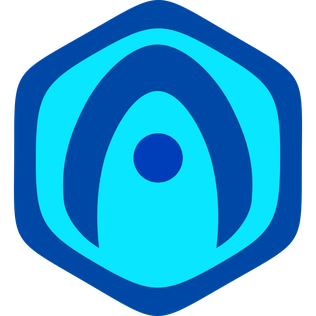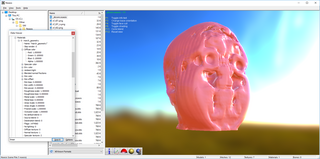
Computer animation is the process used for digitally generating moving images. The more general term computer-generated imagery (CGI) encompasses both still images and moving images, while computer animation only refers to moving images. Modern computer animation usually uses 3D computer graphics.

Autodesk Maya, commonly shortened to just Maya, is a 3D computer graphics application that runs on Windows, macOS, and Linux, originally developed by Alias and currently owned and developed by Autodesk. It is used to create assets for interactive 3D applications, animated films, TV series, and visual effects.
Autodesk, Inc. is an American multinational software corporation that provides software products and services for the architecture, engineering, construction, manufacturing, media, education, and entertainment industries. Autodesk is headquartered in San Francisco, California, and has offices worldwide. Its U.S. offices are located in the states of California, Oregon, Colorado, Texas, Michigan, New Hampshire and Massachusetts. Its Canada offices are located in the provinces of Ontario, Quebec, and Alberta.
Autodesk 3ds Max, formerly 3D Studio and 3D Studio Max, is a professional 3D computer graphics program for making 3D animations, models, games and images. It is developed and produced by Autodesk Media and Entertainment. It has modeling capabilities and a flexible plugin architecture and must be used on the Microsoft Windows platform. It is frequently used by video game developers, many TV commercial studios, and architectural visualization studios. It is also used for movie effects and movie pre-visualization. 3ds Max features shaders, dynamic simulation, particle systems, radiosity, normal map creation and rendering, global illumination, a customizable user interface, and its own scripting language.

OpenSceneGraph is an open-source 3D graphics application programming interface, used by application developers in fields such as visual simulation, computer games, virtual reality, scientific visualization and modeling.
COLLADA is an interchange file format for interactive 3D applications. It is managed by the nonprofit technology consortium, the Khronos Group, and has been adopted by ISO as a publicly available specification, ISO/PAS 17506.
The Advanced Visualizer (TAV), a 3D graphics software package, was the flagship product of Wavefront Technologies from the 1980s until the 1990s.
Mudbox is a proprietary computer-based 3D sculpting and painting tool. Currently developed by Autodesk, Mudbox was created by Skymatter, founded by Tibor Madjar, David Cardwell and Andrew Camenisch, former artists of Weta Digital, where the tool was first used to produce the 2005 Peter Jackson remake of King Kong. Mudbox's primary application is high-resolution digital sculpting, texture painting, displacement map creation, and normal map creation, although it is also used as a design tool.
Navisworks is a 3D design review package for Microsoft Windows.

3D computer graphics, sometimes called CGI, 3-D-CGI or three-dimensional computer graphics, are graphics that use a three-dimensional representation of geometric data that is stored in the computer for the purposes of performing calculations and rendering digital images, usually 2D images but sometimes 3D images. The resulting images may be stored for viewing later or displayed in real time.
MotionBuilder is a 3D character animation software produced by Autodesk. It is used for virtual cinematography, motion capture, and traditional keyframe animation. It was originally named Filmbox when it was first created by Canadian company Kaydara, later acquired by Alias and renamed to MotionBuilder. Alias in turn was acquired by Autodesk.
3D computer graphics software refers to programs used to create 3D computer-generated imagery.
FBX (Filmbox) is a proprietary file format developed by Kaydara and owned by Autodesk since 2006. It is used to provide interoperability between digital content creation applications. FBX is also part of Autodesk Gameware, a series of video game middleware.
iClone is a real-time 3D animation and rendering software program. Real-time playback is enabled by using a 3D videogame engine for instant on-screen rendering.
Alembic is an interchangeable computer graphics file format developed by Sony Pictures Imageworks and Industrial Light & Magic. It was announced at SIGGRAPH 2011, and has been widely adopted across the industry by visual effects and animation professionals.

glTF is a standard file format for three-dimensional scenes and models. A glTF file uses one of two possible file extensions: .gltf (JSON/ASCII) or .glb (binary). Both .gltf and .glb files may reference external binary and texture resources. Alternatively, both formats may be self-contained by directly embedding binary data buffers. An open standard developed and maintained by the Khronos Group, it supports 3D model geometry, appearance, scene graph hierarchy, and animation. It is intended to be a streamlined, interoperable format for the delivery of 3D assets, while minimizing file size and runtime processing by apps. As such, its creators have described it as the "JPEG of 3D."

Verge3D is a real-time renderer and a toolkit used for creating interactive 3D experiences running on websites.

Noesis is software for viewing, converting, and reverse engineering data. Common data types supported by the software include images, 3D models, medical imaging (DICOM), and animation.





